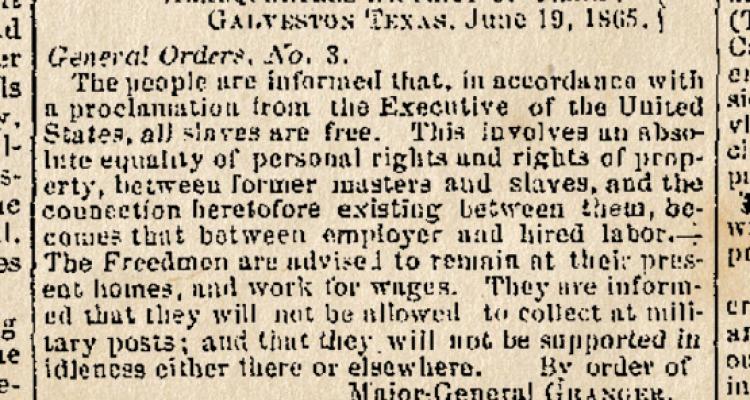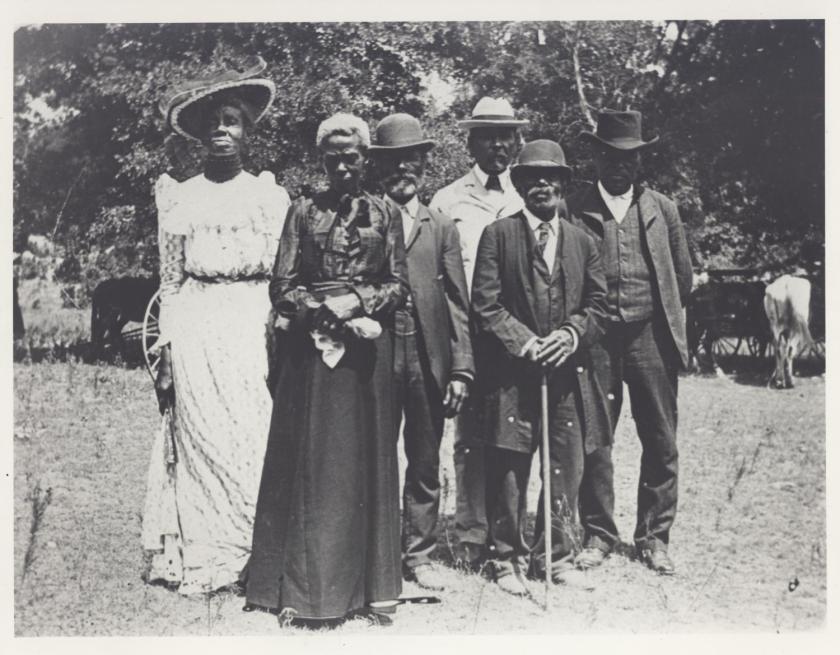
Austin, Texas, on June 19, 1900
Juneteenth commemorates General Order No. 3 which was issued by Major General Gordon Granger, who arrived in Galveston, Texas, on June 19, 1865. The issuing of this order and the arrival of Federal troops in Galveston effectively ended the Civil War and emancipated those confined to a life of slavery. Specifically, Granger made the following declaration in General Order No. 3:
"The people of Texas are informed that, in accordance with a proclamation from the Executive of the United States, all slaves are free. This involves an absolute equality of personal rights and rights of property between former masters and slaves, and the connection heretofore existing between them becomes that between employer and hired labor."

On January 1, 1863, President Abraham Lincoln's Emancipation Proclamation declared "that all persons held as slaves'' within the rebellious states "are, and henceforward shall be free." Because the Southern Confederacy viewed themselves as an independent nation, the Emancipation Proclamation did not immediately free all of the enslaved population because the Rebel governments would not enforce Lincoln’s proclamation. Texas became a stronghold of Confederate influence in the latter years of the Civil War as the slaveholding population 'refugeed' their slave property by migrating to Texas. Consequently, more than 50,000 enslaved individuals were relocated to Texas, effectively prolonging slavery in a region far from the Civil War's bloodshed, and out of the reach of freedom—the United States Army. Only after the Union army forced the surrender of Confederate General Edmund Kirby Smith at Galveston on June 2, 1865, would the emancipation of slaves in Texas be addressed and freedom granted. On June 19, 250,000 enslaved people were freed.

The issuing of General Order No. 3 on June 19, 1865, marked an official date of emancipation for the enslaved population. Nonetheless, those affected faced numerous barriers to their freedoms. General Order No. 3 stipulated that former slaves remain at their present homes, were barred from joining the military, and would not be supported in 'idleness.' Essentially, the formerly enslaved were granted nothing beyond the title of emancipation. The official end of slavery in the United States came with the ratification of the 13th Amendment in 1865.
After becoming emancipated, many former slaves left Texas in great numbers. Most members of this exodus had the goal of reuniting with lost family members and paving a path to success in postbellum America. This widespread migration of former slaves after June 19 became known as 'the Scatter.'

On June 17, 2021, President Biden signed the Juneteenth National Independence Day Act, which officially made Juneteenth a federal holiday. This holiday is the first holiday to be approved since President Ronald Reagan signed a 1983 bill that approved Martin Luther King Jr. Day as a federal holiday. Juneteenth is also recognized as Freedom Day, Jubilee Day, Cel-Liberation Day, Second Independence Day, and Emancipation Day. Juneteenth celebrations often include public readings of the Emancipation Proclamation, singing traditional songs, and reading of works by noted African American writers. Celebrations also take the form of rodeos, street fairs, cookouts, family reunions, park parties, historical reenactments, and Miss Juneteenth contests.



